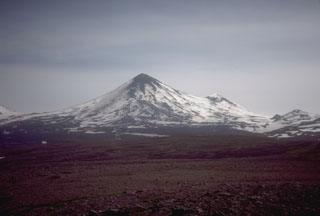Report on Pavlof (United States) — March 1984
Scientific Event Alert Network Bulletin, vol. 9, no. 3 (March 1984)
Managing Editor: Lindsay McClelland.
Pavlof (United States) Vapor plume to 6 km altitude
Please cite this report as:
Global Volcanism Program, 1984. Report on Pavlof (United States) (McClelland, L., ed.). Scientific Event Alert Network Bulletin, 9:3. Smithsonian Institution. https://doi.org/10.5479/si.GVP.SEAN198403-312030
Pavlof
United States
55.417°N, 161.894°W; summit elev. 2493 m
All times are local (unless otherwise noted)
At 1225 on 16 March, the pilot of Air Pacific flight S27 observed a white vapor plume rising to 6 km altitude from the volcano and drifting NW. There had been no eyewitness reports of activity at Pavlof since 15 December 1983 (8:12). After an increase on 17-21 December, seismicity decreased to the background level of several tens of events per day and remained at that level as of 2 April.
Geological Summary. The most active volcano of the Aleutian arc, Pavlof is a Holocene stratovolcano that was constructed along a line of vents extending NE from the Emmons Lake caldera. Pavlof and Pavlof Sister to the NE form a dramatic pair of symmetrical, glacier-covered stratovolcanoes that overlook Pavlof and Volcano bays. Little Pavlof is a smaller cone on the SW flank of Pavlof volcano, near the rim of Emmons Lake caldera. Unlike Pavlof Sister, eruptions have frequently been reported from Pavlof, typically Strombolian to Vulcanian explosive eruptions from the summit vents and occasional lava flows. The active vents lie near the summit on the north and east sides. The largest recorded eruption took place in 1911, at the end of a 5-year-long eruptive episode, when a fissure opened on the N flank, ejecting large blocks and issuing lava flows.
Information Contacts: M. E. Yount, USGS, Anchorage; S. McNutt, LDGO.

